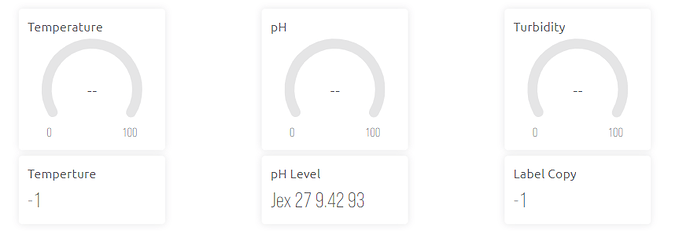I need help to figure out whats wrong in my code connecting in blynk app
Arduino Code
#include <LoRa.h>
#include <OneWire.h>
#include <DallasTemperature.h>
#define ONE_WIRE_BUS 7
OneWire oneWire(ONE_WIRE_BUS);
DallasTemperature DS18B20(&oneWire);
const int sensorpin = A0;
int counter = 0;
String data = "Jex";
int temp, volt;
void setup() {
Serial.begin(9600);
while (!Serial);
Serial.println("LoRa Sender");
LoRa.setPins(10, 9, 2); // 10, 9 for UNO, 53, 9 for Mega, 15, 16, for ESP8266
if (!LoRa.begin(433E6)) {
Serial.println("Starting LoRa failed!");
while (1);
}
}
void loop() {
float sensorValue = analogRead(sensorpin);
float volt = sensorValue * (3.3 / 1025.0) * 3; // Convertion
DS18B20.requestTemperatures();
temp = DS18B20.getTempCByIndex(0); // Celcius
Serial.print("Sending packet: ");
Serial.println(counter);
Serial.print("Temperature: ");
Serial.println(temp);
Serial.print("Turbidity: ");
Serial.println(volt);
// send packet
LoRa.beginPacket();
LoRa.println(data);
LoRa.println(temp);
LoRa.println(volt);
LoRa.print(counter);
LoRa.endPacket();
counter++;
delay(5000);
}
Nodemcu Code
#include <LoRa.h>
#include<ESP8266WiFi.h>
#include <BlynkSimpleEsp8266.h>
#define BLYNK_TEMPLATE_ID "TMPLu_JPWrOy"
#define BLYNK_TEMPLATE_NAME "WATER QUALITY MONITORING SYSTEM USING LORA"
#define BLYNK_AUTH_TOKEN "XUkl9QTecRSQCYd7y2KDUTqyv9zNcn9C"
#define BLYNK_PRINT Serial
char auth[] = "XUkl9QTecRSQCYd7y2KDUTqyv9zNcn9C";
char ssid[]="Pro";
char password[]="123456789";
float temp,ph,volt;
BlynkTimer timer;
void setup() {
Serial.begin(9600);
Blynk.begin(auth, ssid, pass, "blynk.cloud");
timer.setInterval(1000L, sendSensor);
while (!Serial);
Serial.println("LoRa Receiver");
LoRa.setPins(15, 16, 2); // 10, 9 for UNO, 53, 9 for Mega, 15, 16, for ESP8266
if (!LoRa.begin(433E6)) {
Serial.println("Starting LoRa failed!");
while (1);
}
}
void loop() {
Blynk.run();
timer.run();
// try to parse packet
int packetSize = LoRa.parsePacket();
if (packetSize) {
// received a packet
Serial.print("Received packet '");
Serial.println("Temperature: ");
Serial.println("Turbidity: ");
Serial.println("pH: ");
// read packet
while (LoRa.available()){
String data = LoRa.readString();
Serial.println(data);
String temp = LoRa.readString();
Serial.println(temp);
String volt = LoRa.readString();
Serial.print(volt);
String ph = LoRa.readString();
Serial.println(ph);
}
// print RSSI of packet
Serial.print("' with RSSI ");
Serial.println(LoRa.packetRssi());
}
}
void sendSensor()
{
Blynk.virtualWrite(V0,temp);
Blynk.virtualWrite(V1,ph);
Blynk.virtualWrite(V2,volt);
}
